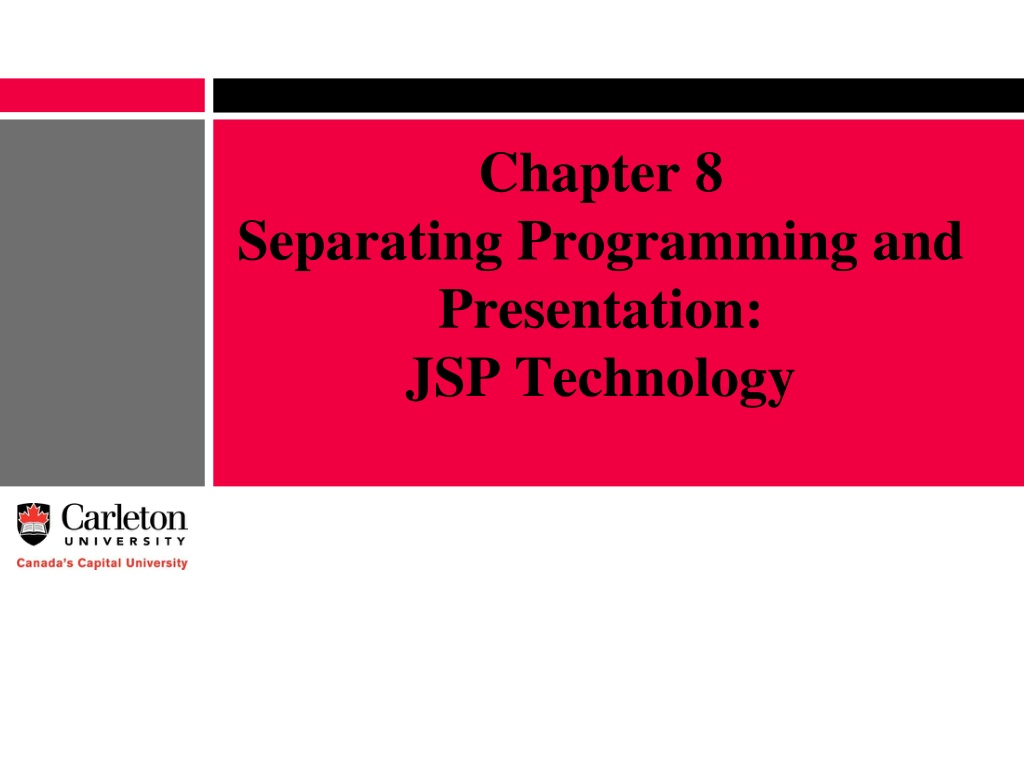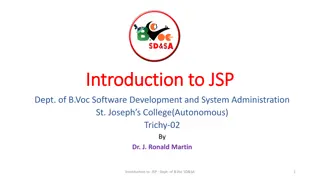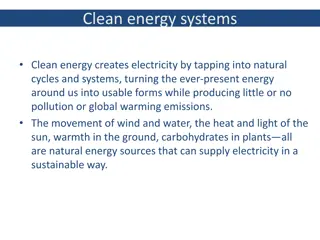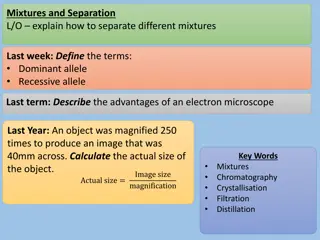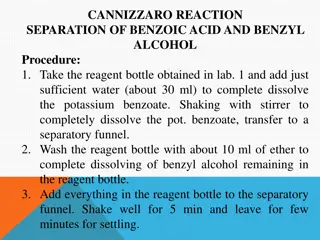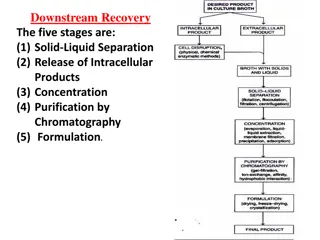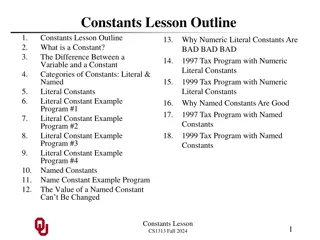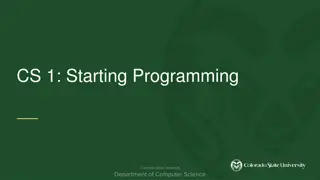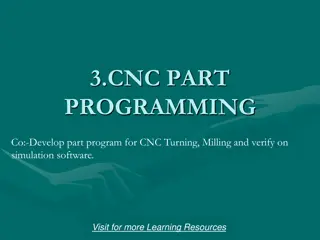Exploring JSP Technology for Cleaner Programming and Presentation Separation
JSP technology allows for a clean separation of programming logic from presentation, enabling collaboration between developers and designers. By embedding Java code within HTML, JSP facilitates a more efficient and organized web development process. This article delves into the benefits of using JSP over traditional CGI and Servlet approaches, showcasing examples and highlighting the core features of JSP technology.
Download Presentation

Please find below an Image/Link to download the presentation.
The content on the website is provided AS IS for your information and personal use only. It may not be sold, licensed, or shared on other websites without obtaining consent from the author. Download presentation by click this link. If you encounter any issues during the download, it is possible that the publisher has removed the file from their server.
E N D
Presentation Transcript
Chapter 8 Separating Programming and Presentation: JSP Technology
Why JSP? Servlet/CGI approach: server-side code is a program with HTML embedded JavaServer Pages (and PHP/ASP/ColdFusion) approach: server-side code is a document with program embedded Supports cleaner separation of program logic from presentation Facilitates division of labor between developers and designers , , Is the latter a big deal? (example: Doug, MKS Software Developer)
JSP Example Default namespace is XHTML
JSP Example Also uses two JSP-defined namespaces
JSP Example JSP-defined markup (initialization)
JSP Example Standard XHTML
JSP Example JSP scriptlet
JSP Example JSP-based program logic: initialize and increment variable
JSP Example Replaced with value of variable
JSP Example Output XHTML document after 3 visits
JSP Example Used html as root element Can use HTML-generating tools, such as Mozilla Composer, to create the HTML portions of the document JSP can generate other XML document types as well ,
JSP Example Namespaces JSP (basic elements, normal prefix jsp) Core JSP Standard Tag Library (JSTL) (prefix c) , Tag library: means of adding functionality beyond basic JSP , JSTL included in with JWSDP 1.3 version of Tomcat , JSTL provides tag libraries in addition to core (more later) ,
JSP Example JSP elements directive.page: typical use to set HTTP response header field, as shown (default is text/xml) output: similar to XSLT output element (controls XML and document type declarations) ,
JSP Example Template data: Like XSLT, this is the HTML and character data portion of the document , Scriptlet: Java code embedded in document While often used in older (non-XML) JSP pages, we will avoid scriptlet use One use (shown here) is to add comments that will not be output to the generated page ,
JSP Example Core tag library supports simple programming if: conditional , empty: true if variable is non-existent or undefined set: assignment , application scope means that the variable is accessible by other JSP documents, other users (sessions) ,
JSP and Servlets JSP documents are not executed directly When a JSP document is first visited, Tomcat 1. Translates the JSP document to a servlet 2. Compiles the servlet The servlet is executed Exceptions provide traceback information for the servlet, not the JSP The servlets are stored under Tomcat work directory , ,
JSP and Servlets A JSP-generated servlet has a _jspService() method rather than doGet() or doPost() This method begins by automatically creating a number of implicit object variables that can be accessed by scriptlets ,
JSP and Servlets Translating template data: , Scriptlets are copied as-is to servlet: ,
JSP and Servlets Sciptlets can be written to use the implicit Java objects: , We will avoid this because: It defeats the separation purpose of JSP We can incorporate Java more cleanly using JavaBeans technology and tag libraries ,
JSP and Servlets JSP elements translate to: , JSP default ${visits} in template code translates to out.write() of value of variable Core tags (e.g., if) normally translate to a method call , ,
Web Applications A web application is a collection of resources that are used together to implement some web-based functionality , Resources include Components: servlets (including JSP-generated) Other resources: HTML documents, style sheets, JavaScript, images, non-servlet Java classes, etc. ,
Web Applications Sharing data between components of a web application Tomcat creates one ServletContext object per web application Call to getServletContext() method of a servlet returns the associated ServletContext ServletContext supports setAttribute()/getAttribute() methods , Difference to HttpSession? Similarities?
Web Applications Within Tomcat, all of the files of a simple web app are placed in a directory under webapps JSP documents can go in the directory itself Hidden files--such as servlet class files--go under a WEB-INF subdirectory (more later) , Once the web app files are all installed, used Tomcat Manager to deploy the app , You did that for Assignment 4 already . ,
Web Applications , Deploying a web app consisting of a single JSP document HelloCounter.jspx: Create directory webapps/HelloCounter Copy JSP doc to this directory Visit localhost:8080/manager/html Enter HelloCounterin WAR or Directory URL box and click Deploy button , Web app is now at URL localhost:8080/HelloCounter/ HelloCounter.jspx
Web Applications Manager app: Stop: web app becomes unavailable (404 returned) Start: web app becomes available again Reload: stop web app, restart with latest versions of files (no need to restart server) Undeploy: stop app and remove all files! , Always keep a copy of app outside webapps ,
Web Applications Set parameters of a web application by Creating a deployment descriptor (XML file) Saving the descriptor as WEB-INF/web.xml Simple example web.xml: , ,
Web Applications Example Deployment Description from Assignment 4 <?xml version="1.0" encoding="ISO-8859-1"?> <web-app xmlns="http://java.sun.com/xml/ns/j2ee" xmlns:xsi="http://www.w3.org/2001/XMLSchema-instance" xsi:schemaLocation="http://java.sun.com/xml/ns/j2ee http://java.sun.com/xml/ns/j2ee/web-app_2_4.xsd" version="2.4"> <display-name>Crazy8 Game with State</display-name> <description> This is the Solution to Assignment 4 in SYSC 4504, Fall 2011. </description> <servlet> <servlet-name>CrazyState</servlet-name> <servlet-class>CrazyState</servlet-class> </servlet> <servlet-mapping> <servlet-name>CrazyState</servlet-name> <url-pattern>/CrazyState</url-pattern> </servlet-mapping> </web-app>
Web Applications Some examples: Setting an initial value accessible by application.getInitParameter(): , Setting the length of time (in minutes) before a session times out:
Web Applications Mapping URLs to app components: ,
Web Applications There are four URL patterns (from high to low precedence) , If no URL pattern matches, Tomcat treats path as a relative file name ,
Web Applications Methods on request object for obtaining path information: Example: /HelloCounter/visitor/test.jsp getContextPath(): returns /HelloCounter getServletPath(): returns /visitor getPathInfo(): returns /test.jsp ,
JSP Expression Language (EL) ${visits+1} is an example of an EL expression embedded in a JSP document ${ } is the syntax used in JSP documents to mark the contained string as an EL expression An EL expression can occur , In template data: evaluates to Java String , As (part of) the value of certain JSP attributes: evaluates to data type that depends on context ,
JSP Expression Language (EL) EL literals: true, false decimal integer, floating point, scientific-notation numeric literals strings (single- or double-quoted) null ,
JSP Expression Language (EL) EL variable names: like Java Can contain letters, digits, _ , and $ Must not begin with a digit Must not be reserved: ,
JSP Expression Language (EL) , EL operators: Relational: <, >, <=, >=, ==, != , Or equivalents: lt, gt, le, ge, eq, ne Logical: &&, ||, ! , Or equivalents: and, or, not Arithmetic: , +, - (binary and unary), * , /, % (or div, mod) empty: true if arg is null or empty string/array/Map/Collection Conditional: ? : Array access: [ ] (or object notation) Parentheses for grouping
JSP Expression Language (EL) EL automatic type conversion Conversion for + is like other binary arithmetic operators (+ does not represent string concatenation) Otherwise similar to JavaScript ,
JSP Expression Language (EL) EL provides a number of implicit objects , Most of these objects are related to but not the same as the JSP implicit objects JSP implicit objects cannot be accessed directly by name in an EL expression, but can be accessed indirectly as properties of one of the EL implicit objects ,
JSP Expression Language (EL) , pageContext: provides access to JSP implicit objects Ex: EL expression pageContext.request is reference to the JSP request object , page: JSP implicit object representing the servlet itself , JSP objects page, request, session, and application all have getAttribute() and setAttribute() methods These objects store EL scoped variables (e.g., visits)
JSP Expression Language (EL) , Reference to non-implicit variable is resolved by looking for an EL scoped variable in the order: page request session application , If not found, value is null , If found, value is Object JSP automatically casts this value as needed
JSP Expression Language (EL) All EL implicit objects except pageContext implement Java Map interface In EL, can access Map using array or object notation: Servlet: request.getParameter( p1 ) EL: param[ p1 ] or param.p1 , ,
JSP Expression Language (EL) Array/List access: If EL scoped variable aVar represents , Java array; or , java.util.List and if EL scoped variable index can be cast to integer then can access elements of aVar by , aVar[index] , aVar.index ,
